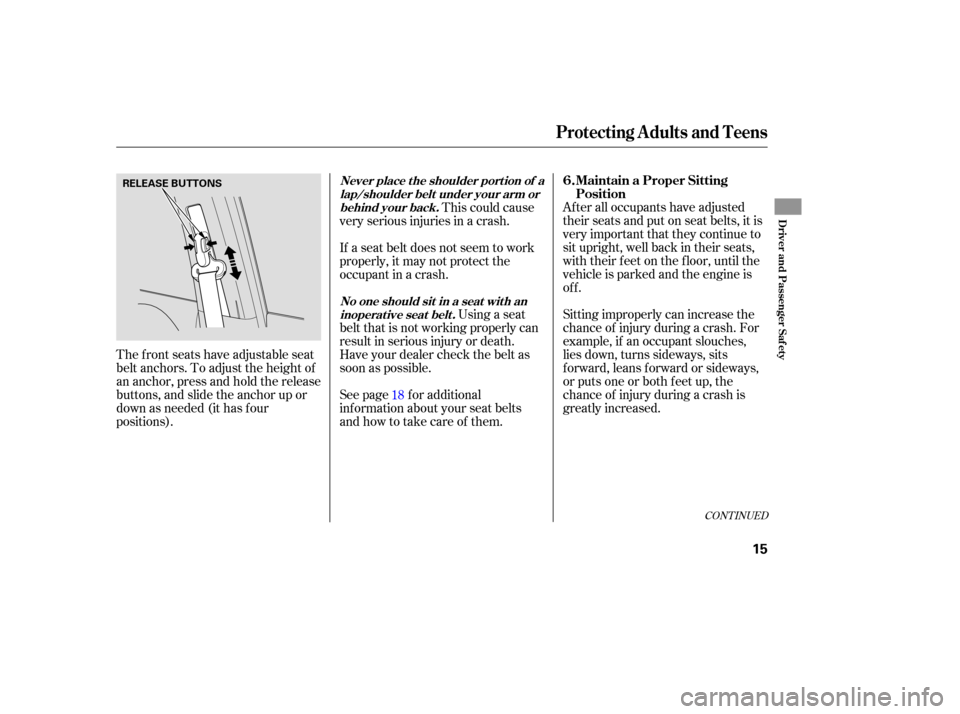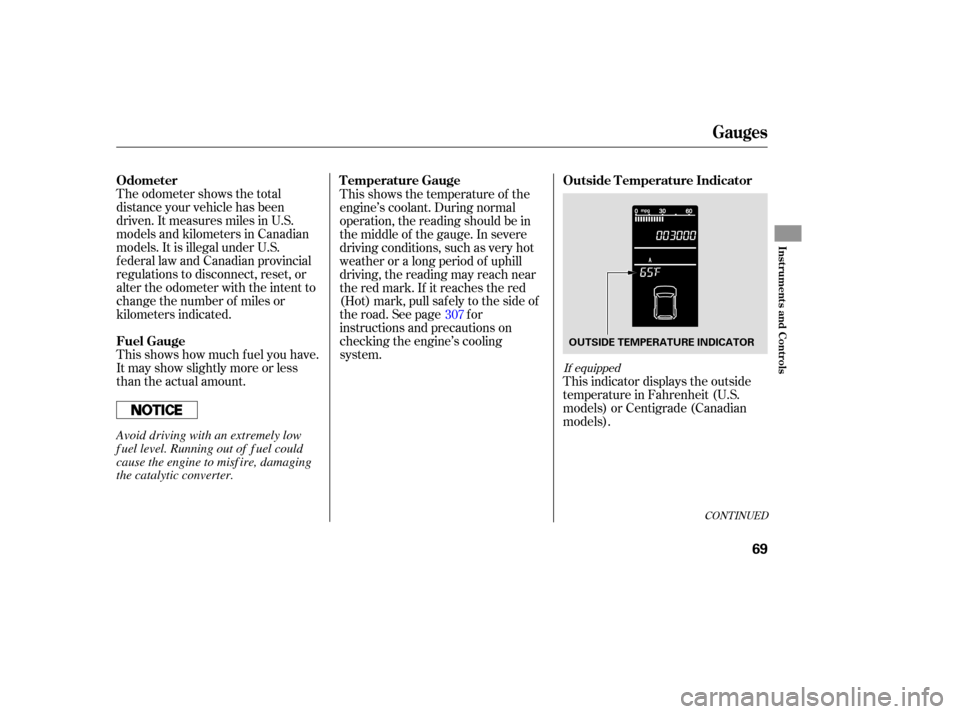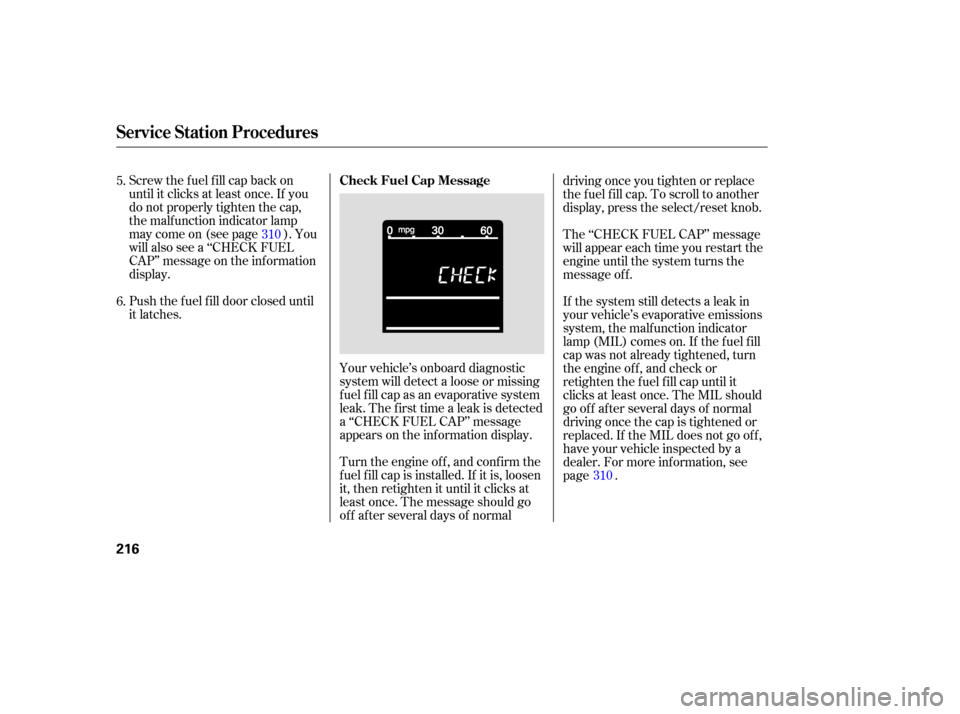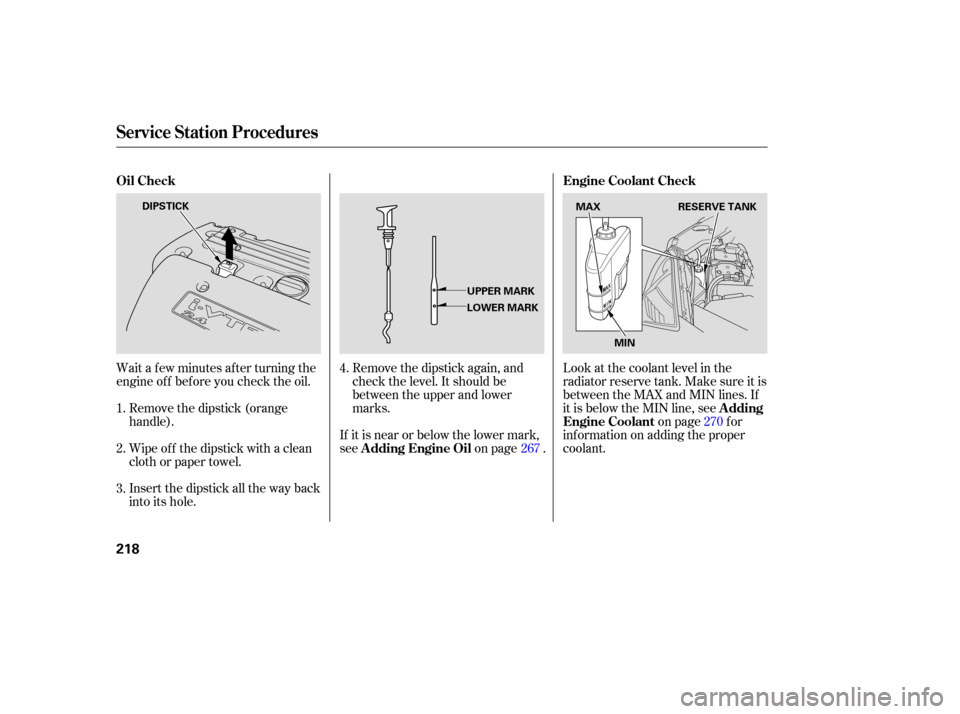check engine HONDA CR-V 2007 RD1-RD5, RE7 / 3.G Owners Manual
[x] Cancel search | Manufacturer: HONDA, Model Year: 2007, Model line: CR-V, Model: HONDA CR-V 2007 RD1-RD5, RE7 / 3.GPages: 352, PDF Size: 5.77 MB
Page 19 of 352

After all occupants have adjusted
their seats and put on seat belts, it is
very important that they continue to
sit upright, well back in their seats,
with their feet on the floor, until the
vehicle is parked and the engine is
off.
Sitting improperly can increase the
chance of injury during a crash. For
example, if an occupant slouches,
lies down, turns sideways, sits
forward, leans forward or sideways,
or puts one or both feet up, the
chance of injury during a crash is
greatly increased.
The
front seats have adjustable seat
belt anchors. To adjust the height of
an anchor, press and hold the release
buttons, and slide the anchor up or
down as needed (it has f our
positions). This could cause
very serious injuries in a crash.
See page f or additional
inf ormation about your seat belts
and how to take care of them. Using a seat
belt that is not working properly can
result in serious injury or death.
Have your dealer check the belt as
soon as possible. If a seat belt does not seem to work
properly, it may not protect the
occupant in a crash.
18
CONT INUED
Maintain a Proper Sitting
Position
6.Never place t he shoulder port ion of a
lap/shoulder belt under your arm orbehind your back.
No one should sit in a seat wit h aninoperat ive seat belt .
Protecting A dults and Teens
Driver and Passenger Saf ety
15
RELEASE BUTTONS
Page 35 of 352

The SRS indicator alerts
you to a poten tial problem
with your airbags or seat belt
tensioners.
Wh en you turn the ignition switch to
the ON (II) position, this indicator
comes on briefly then goes off. This
tells you the system is wo rking
properly.
If the indicator comes on or
flashesonandoffwhileyoudrive. If the indicator stays on after the
engine starts.
If
the SRS indicator does not come
on after you turn the ignition
switch to the ON (II) position.
If
the indicator comes on at any
other time, or does not come on at all,
you should have the system checked
by your dealer. For example: If
you see any of these indications,
the airbags and seat belt tensioners
may not work properly when you
need them.
This indicator alerts you that the
passenger’s side airbag has been
automatically shut off. It does
mean there is a problem with your
side airbags.
When you turn the ignition switch to
the ON (II) position, the indicator
should come on brief ly and then go
off(seepage ).Ifitdoesn’tcome
on, stays on, or comes on while
driving without a passenger in the
f ront seat, have the system checked. 61
How the Side Airbag Of f
Indicator Works
How the SRS Indicator Works
not
Additional Inf ormation About Your Airbags
Driver and Passenger Saf ety
31
U.S. Canada
Ignoring the SRS indicator can
result in serious injury or death
if the airbag systems or
tensioners do not work properly.
Have your vehicle checked by a
dealer as soon as possible if
the SRS indicator alerts you to
a possible problem.
Page 64 of 352

The instrument panel has many
indicato rs that give you important
info rmation about your vehicl e.
See page .
If this indicator comes on when the
engine is running, the battery is not
being charged. For more information,
see page .
The
engine can be severely damaged
if this indicator flashes or stays on
wh en the engine is running. For
more information, see page .This
indicator has two functions: This
indicator comes on when you
turn the ignition switch to the ON
(II) position. It reminds you and your
passengers to fasten your seat belts.
A beeper also sounds if you have not
fastened your seat belt.
Itcomesonwhenyouturnthe
ignition switch to the ON (II)
position. It is a reminder to check
the parking brake. A beeper
sounds if you drive with the
parking brake not fully released.
Driving with the parking brake not
fully released can damage the
brakes and tires.
If it stays on after you have fully
released the parking brake while
the engine is running, or if it
comes on while driving, there
could be a problem with the brake
system. For more inf ormation, see
page . If you turn the ignition switch to the
ON (II) position bef ore f astening
your seat belt, the beeper sounds,
and the indicator f lashes. If you do
notfastenyourseatbeltbeforethe
beeper stops, the indicator stops
f lashing but remains on.
If your f ront passenger does not
f asten their seat belt, the indicator
comes on about 6 seconds af ter the
ignition switch is turned to the ON
(II) position.
2. 1.
310
309
309 311
Malf unction Indicator
Lamp
L ow Oil Pressure
Indicator
Charging System
Indicator
Seat Belt Reminder
Indicator
Parking Brake and Brake System
Indicator
Instrument Panel Indicators
60
U.S. Canada
Page 65 of 352

This indicator comes on when you
turn the ignition switch to the ON
(II) position. If it comes on at any
other time, it indicates that the
passenger’s side airbag has
automatically shut off. For more
info rmation, see page .
If
either of you do not fasten your
seat belt while driving, the beep er
will sound and the indicator will flash
again at regular intervals. For more
info rmation, see page .
This indicator comes on briefly when
you turn the ignition switch to the
ON (II) position. If it comes on at
any other time, it indicates a
poten tial problem with your front
airbags. This indica tor will also alert
you to a poten tial problem with your
side airbags, passenger’s side airbag
automatic cutoff system, side curtain
airbags, automatic seat belt
tensioners, driver’s seat position
sensor, or the front passenger’s
weight sensors. For more
info rmation, see page . This
indicator comes on briefly when
you turn the ignition switch to the
ON (II) position. It will then go off if
you have inserted a properly-coded
ignition key. If it is not a properly-
coded key, the indicator will blink,
and the engine’s fuel system will be
disabled. (see page ). This
indicator normally comes on for
a few seconds when you turn the
ignition switch to the ON (II)
position, and when the ignition
switch is turned to the START (III)
position. If it comes on at any other
time, there is a problem in the ABS.
If this happens, have your vehicle
checked by your dealer. With the
indicator on, your vehicle still has
norm al braking ability but no anti-
lock. For more inf ormation, see page .
31
31
18
80238
Instrument Panel Indicators
Side Airbag Of f Indicator
Supplemental Restraint
System Indicator
Immobilizer System
IndicatorAnti-lock Brake System
(A BS) Indicator
Inst rument s and Cont rols
61
Canada
U.S.
Page 73 of 352

The odometer shows the total
distance your vehicle has been
driven. It measures miles in U.S.
models and kilometers in Canadian
models. It is illegal under U.S.
federal law and Canadian provincial
regulations to disconnect, reset, or
alter the odometer with the intent to
ch ange the number of miles or
kilometers indicated.
This indicator displays the outside
temperature in Fah renheit (U.S.
models) or Cen tigrade (Canadian
models).
This
shows how much fuel you have.
It may show slightly more or less
th an the actual amount. This
shows the temperature of the
engine’s coolant. During normal
operation, the reading should be in
the middle of the gauge. In severe
driving conditions, such as very hot
weather or a long period of uphill
driving, the reading may reach near
the red mark. If it reaches the red
(Hot) mark, pull saf ely to the side of
the road. See page f or
instructions and precautions on
checking the engine’s cooling
system. 307
If equipped
CONT INUED
Outside Temperature Indicator
Temperature Gauge
Odometer
Fuel Gauge
Gauges
Inst rument s and Cont rols
69
OUTSIDE TEMPERATURE INDICATOR
Avoid driving with an extremely low
f uel level. Running out of f uel could
cause the engine to misf ire, damaging
the catalytic converter.
Page 75 of 352

If your fuel fill cap is loose or
missing, a ‘‘CHECK FUEL CAP’’
messa ge appears on the information
display after you start the engine.
For more information, see page .The
information display in the
instrument panel shows you the
engine oil life and maintenance
service items when the ignition
switch is in the ON (II) position. This
information helps to keep you aware
of the periodic maintenance your
vehicle needs for continued trouble-
f ree driving. Ref er to page f or
more inf ormation.
216
257
Gauges
Maintenance Minder
Check Fuel Cap Message
Inst rument s and Cont rols
71
Page 217 of 352

Bef ore you begin driving your
vehicle, you should know what
gasoline to use and how to check the
levels of important f luids. You also
need to know how to properly store
luggage or packages. The
inf ormation in this section will help
you. If you plan to add any
accessories to your vehicle, please
read the information in this section
first..............................
Break-in Period .214
.................
Fuel Recommendation .214
.........
Service Station Procedures .215
....................................
Ref ueling .215
........
Check Fuel Cap Message .216
Opening and Closing
................................
the Hood .217
...................................
Oil Check .218
.............
Engine Coolant Check .218
...............................
Fuel Economy .219
...
Accessories and Modif ications .220
.............................
Carrying Cargo .222
Bef ore Driving
Bef ore Driving
213
Page 220 of 352

Screw the fuel fill cap back on
until it clicks at least once. If you
do not properly tighten the cap,
the malfunction indicator lamp
maycomeon(seepage ).You
will also see a ‘‘CHECK FUEL
CAP’’ message on the information
display.
Push the fuel fill door closed until
it latches.
Your vehicl e’s onboard diagnostic
system will detect a loose or missing
fu el fill cap as an evaporative system
leak. The first time a leak is detected
a ‘‘CHECK FUEL CAP’’ message
appears on the information display.
Turn the engine off, and confi rm the
fuel fill cap is installed. If it is, loosen
it, then retighten it until it clicks at
least once. The message should go
off after several days of normal driving
once you tighten or replace
the fuel fill cap. To scroll to another
display, press the select/reset knob.
The ‘‘CHECK FUEL CAP’’ message
will appe ar each time you restart the
engine until the system turns the
message off.
If the system still detects a leak in
your vehicle’s evaporative emissions
system, the malfunction indicator
lamp (MIL) comes on. If the fuel fill
cap was not already tightened, turn
the engine off, and check or
retighten the fuel fill cap until it
clicks at least once. The MIL should
go off after several days of normal
driving once the cap is tightened or
replaced. If the MIL does not go of f ,
have your vehicle inspected by a
dealer. For more inf ormation, see
page .
5.
6.
310
310
Service Station Procedures
Check Fuel Cap Message
216
Page 222 of 352

Wait a few minutes after turning the
engine off before you check the oil.
Remove the dipstick (orange
handle).
Wipe off the dipstick with a clean
cloth or paper towel.
Insert the dipstick all the way back
into its hole. Remove
the dipstick again, and
check the level. It should be
between the upper and lower
marks.
If it is near or below the lower mark,
see on page .Look
at the coolant level in the
radiator reserve tank. Make sure it is
between the MAX and MIN lines. If
it is below the MIN line, see on page f or
inf ormation on adding the proper
coolant.
1.
2.
3. 4.
267 270
Oil Check
A dding Engine OilEngine Coolant Check
A dding
Engine Coolant
Service Station Procedures
218
DIPSTICK
UPPER MARK
LOWER MARKMAX
MIN RESERVE TANK
Page 223 of 352

Refer to
on page for
inform ation about checking other
items on your vehicle. Always
maintain your vehicle
according to the maintenance
messages displayed in the
information display. See
on page
.
an underinf lated tire
causes more ‘‘rolling resistance,’’
which uses more f uel.
The build-up of snow or mud on
your vehicle’s underside adds
weight and rolling resistance.
Frequent cleaning helps your f uel
mileage and reduces the chance of
corrosion.
Drive moderately. Rapid
acceleration, abrupt cornering,
and hard braking use more f uel.
Always drive in the highest gear
possible. Try to maintain a constant speed.
Everytimeyouslowdownand
speed up, your vehicle uses extra
f uel. Use cruise control when
appropriate.
Combine several short trips into
one.
The air conditioning puts an extra
load on the engine which makes it
usemorefuel.Usethefresh-air
ventilation when possible.
262
262
For example,
Owner’s Maintenance
Checks Improving Fuel Economy
Owner’s
Maintenance Checks
Service Station Procedures, Fuel Economy
Bef ore Driving
219